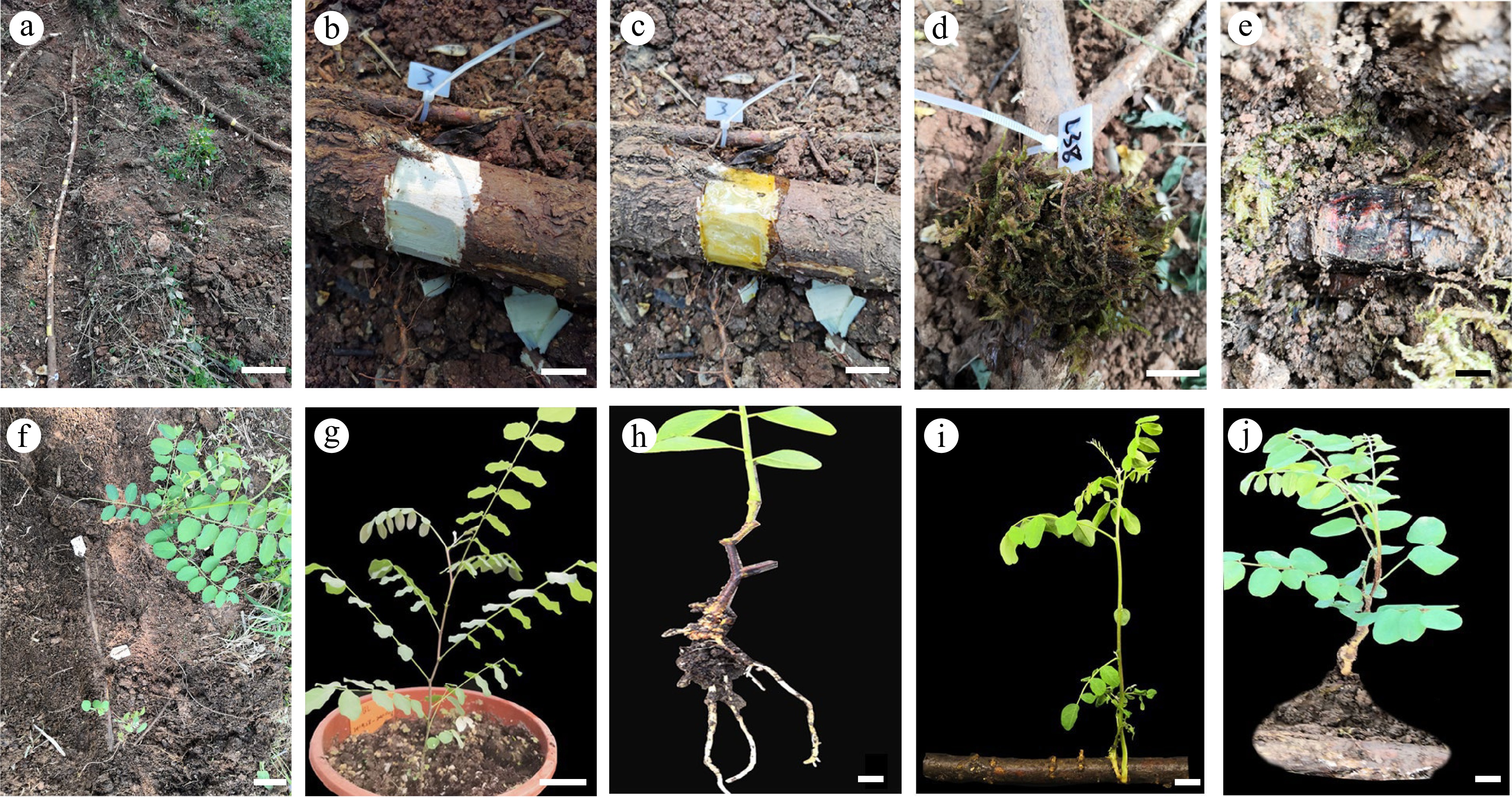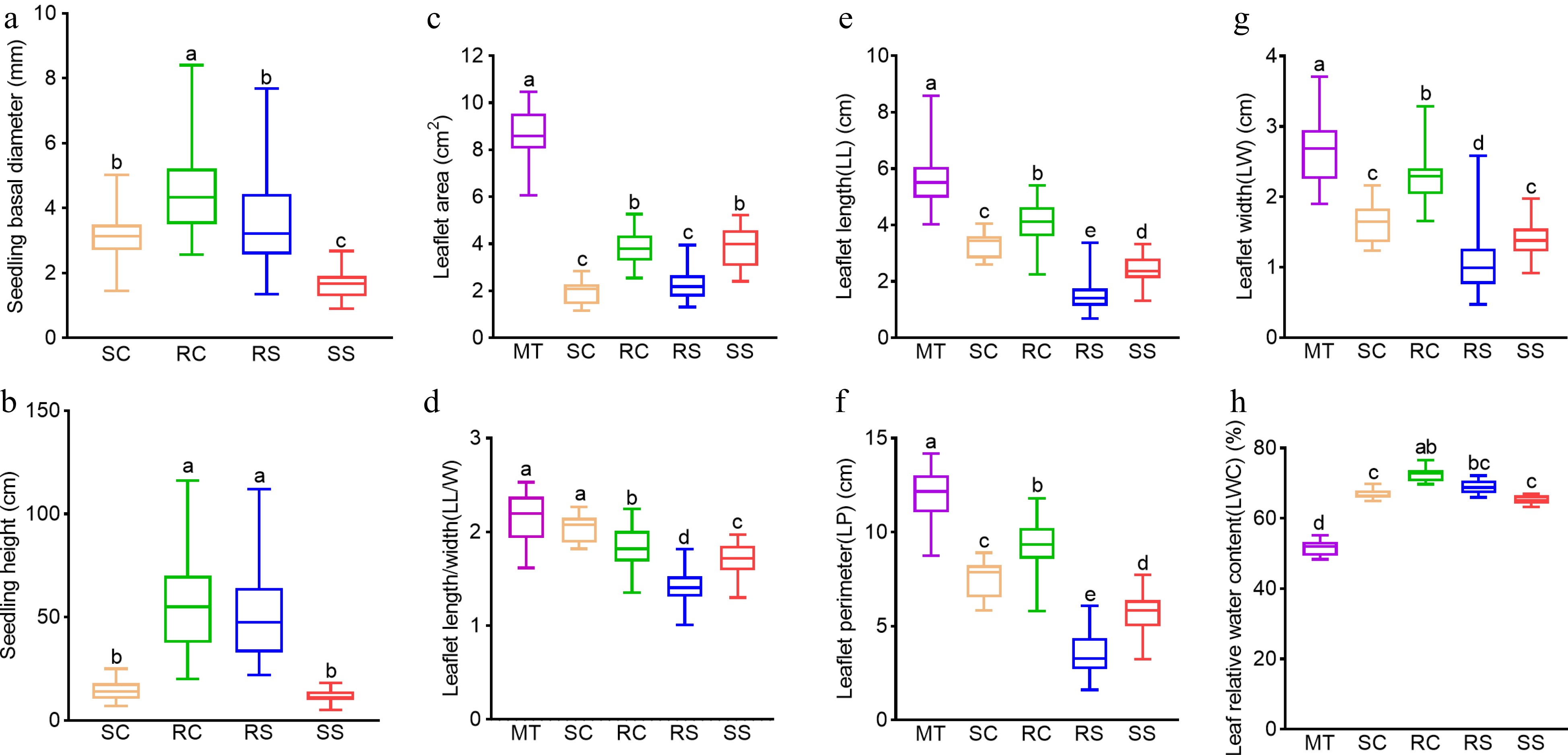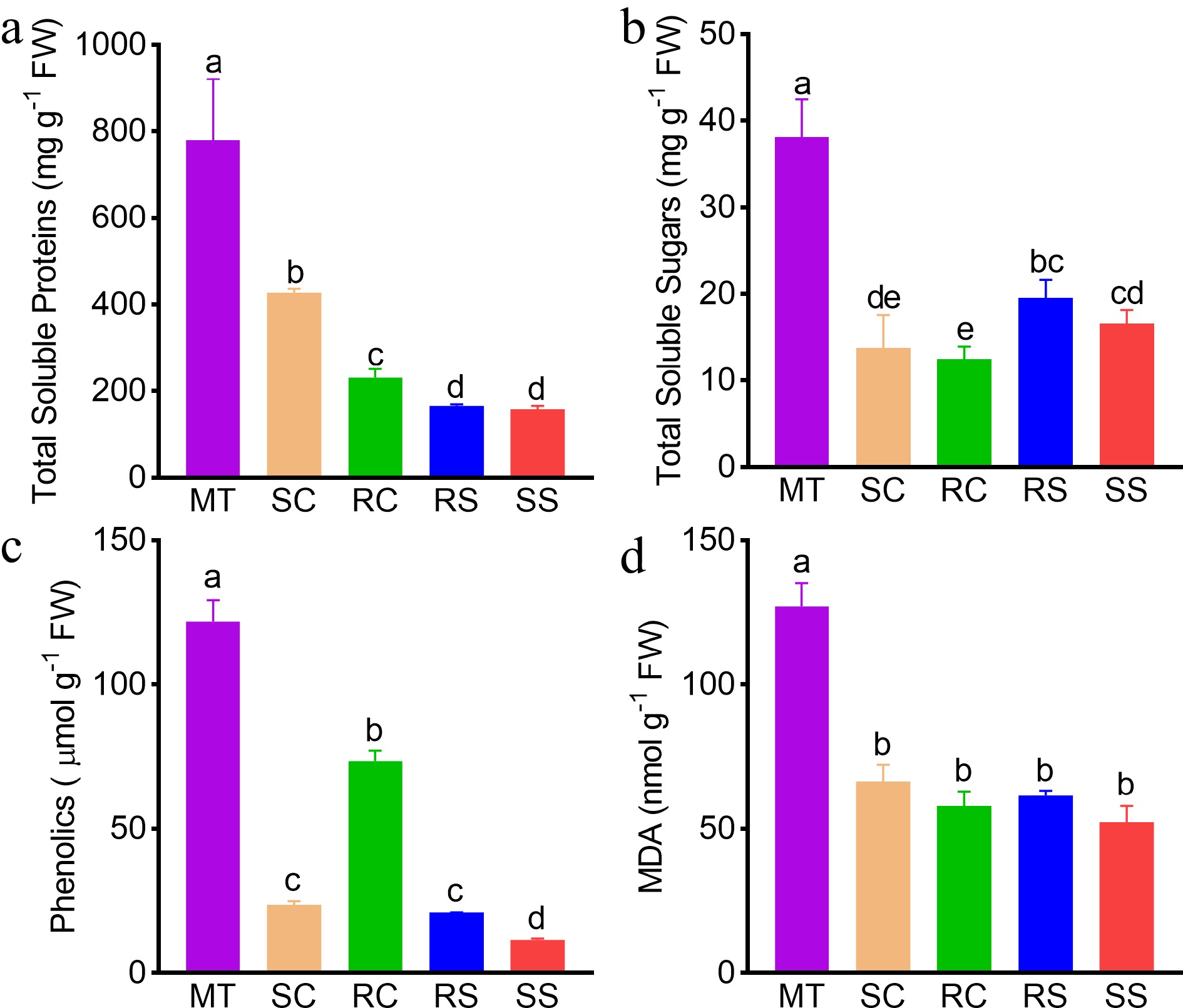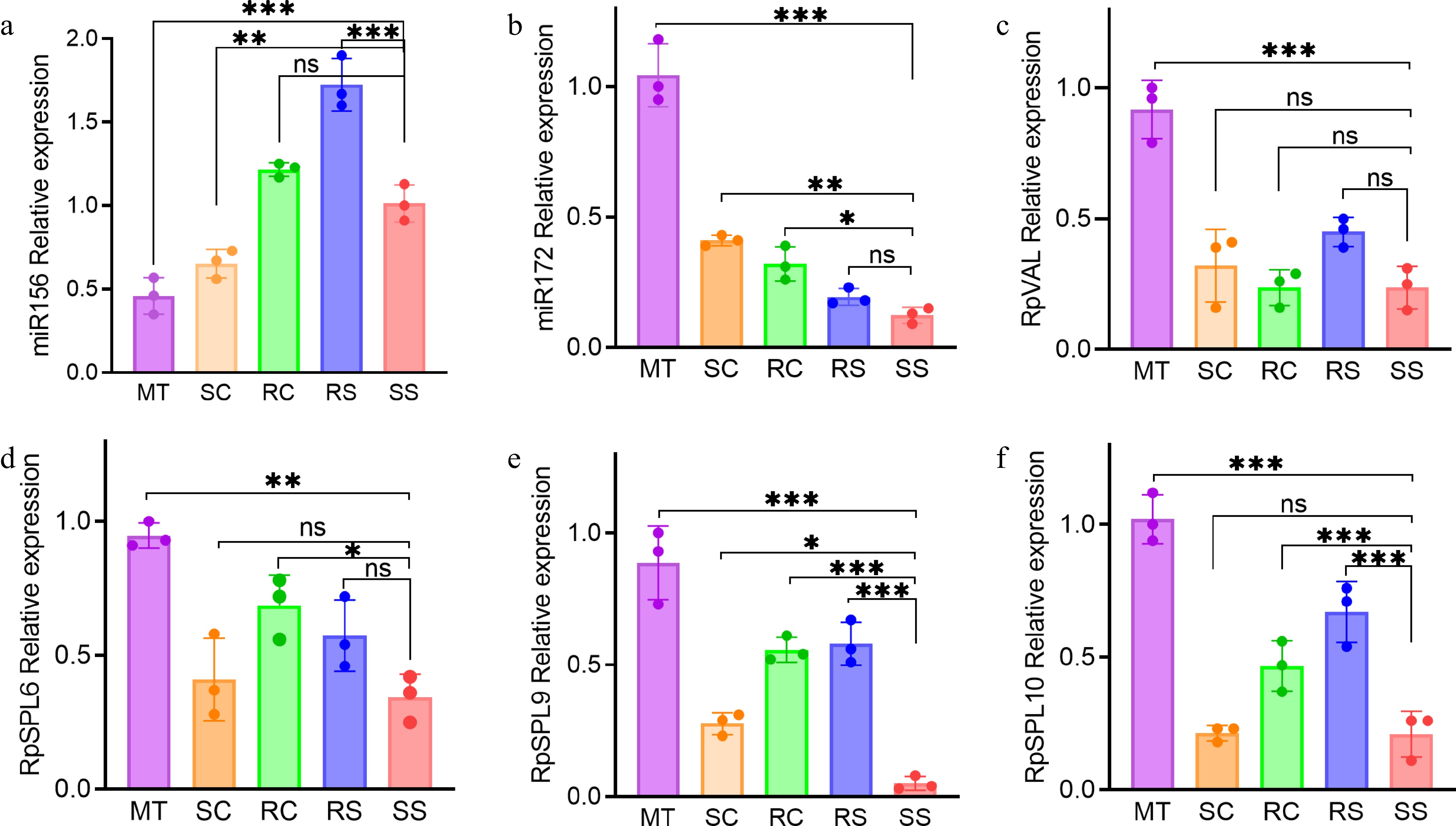-

Figure 1.
Propagation by root-sprouting and examples of black locust plants produced with different propagation methods. (a) Exposure of a woody root. (b) Girdling one quarter of the root circumference. (c) Hormone treatment. (d) Moisturizing treatment. (e) Treated root after 15 d. (f) Germinated plantlets in root-sprouting treatment. (g) Seed-derived seedlings. (h) Plantlets obtained by root-sprouting. (i) Plantlets obtained from root-cuttings. (j) Plantlets obtained from shoot-cutting. Scale bars: (a) 50 cm, (b)−(f) 2 cm, (g), 5 cm, (h)−(j) 2 cm.
-

Figure 2.
Growth and leaf traits of plantlets, seedlings and mother trees. (a) Basal diameter. (b) Seedling height. (c) Leaflet area. (d) Leaflet length/width. (e) Leaflet length. (f) Leaflet perimeter. (g) Leaflet width. (h) Leaf relative water content. Different lowercase letters above the bars indicate significant differences between plant materials (p < 0.05, ANOVA and Tukey's honestly significant difference test). Abbreviations: SS, seed-derived seedlings; RS, root-sprouting plantlets, RC, root-cutting plantlets; SC, shoot-cutting plantlets; MT, mother trees.
-

Figure 3.
Physiological traits of juvenile plantlets/seedlings and mother trees. (a) Total soluble protein. (b) Total soluble sugars. (c) Phenolic content. (d) MDA content. Different lowercase letters above the bars indicate significant differences among plant materials. Abbreviations: SS, seed-derived seedlings; RS, root-sprout plantlets; RC, root-cutting plantlets; SC, shoot-cutting plantlets; MT, mother trees. MDA, malondialdehyde.
-

Figure 4.
Shoot cross-sectional anatomy and leaf-cell ultrastructure of plantlets. (a)–(d) Stem cross sections of (a) SS, (b) RC, (c) RS, and (d) SS. (e)–(s) Ultrathin sections of leaves. SS, seed-derived seedlings; RS, root-sprout plantlets; RC, root-cutting plantlets; SC, shoot-cutting plantlets; MT, mother trees. Abbreviations: Ep, Epidermis; Co, Cortex; Ph, Phloem; Xy, Xylem; Ve, Vessel; Pi, Pith; CW, cell wall; Ch, chloroplast; Mi, mitochondrion; nu, nucleus; SG, starch granule; Va, vacuole; T; thylakoid; O, osmiophilic droplet; Me: nuclear membrane; Chr, chromatin. Scale bars: (a), (b) 50 µm, (e)−(i) 2 µm, (j)−(n) 500 nm, (o)−(s) 1 µm.
-

Figure 5.
Relative expression of genes and microRNAs in the plantlets/seedlings and mother trees. (a) miR156, (b) miR172, (c) RpVAL, (d) RpSPL6, (e) RpSPL9, and (f) RpSPL10. Asterisks indicate statistically significant differences compared to the seed-derived seedlings (* p < 0.05; ** p < 0.01; *** p < 0.001; ns, no significant difference). Abbreviations: SS, seed-derived seedlings; RS, root-sprout plantlets; RC, root-cutting plantlets; SC, shoot-cutting plantlets; MT, mother trees.
-
miRNA/Gene Species Juvenile Adult Function References miR156 A. thaliana Highly expressed − Prolongs juvenility and delays the onset of the adult phase. [30,36] miR172 A. thaliana − Highly expressed Its expression is regulated by miR156 via SPL, thereby regulating plant vegetative phase change. [36,37] SPL3/4/5 A. thaliana − Highly expressed Regulates flowering time and phase change [38,39] SPL9/15 A. thaliana − Highly expressed Promotes juvenile-to-adult phase transition and flowering; directly regulates genes involved in trichome formation. [36,40] SPL2/10/11 A. thaliana − Highly expressed Regulates leaf shape and trichome distribution with shoot maturation in the reproductive phase. [36,39] SPL6/13 A. thaliana − Highly expressed Regulates the switch from cotyledon to vegetative leaf stage. [36] TOE1/2 A. thaliana Highly expressed − Represses flowering [39] VAL1/2 A. thaliana − Highly expressed Both VAL1 and VAL2 regulate vegetative phase change by constitutively decreasing miR156 levels and indirectly promoting SPL expression [27] SPL, SQUAMOSA PROMOTER BINDINGPROTEIN-LIKE; TOE, TARGET OF EAT; VAL, VIVIPAROUS/ABI3-LIKE. Table 1.
Key miRNAs and genes known to function in plant vegetative phase change.
-
MT MT Age (y) SS (N) SC (N) RC (N) RS (N) MT1 18 15 8 7 14 MT2 19 15 1 5 7 MT3 21 15 3 10 13 MT4 17 15 3 0 16 MT5 24 15 8 6 21 Total 75 23 29 71 MT6 16 15 2 0 18 MT7 19 15 2 0 17 MT8 17 15 8 5 10 MT9 22 15 4 10 8 MT10 18 15 4 0 12 Total 75 20 15 65 MT11 20 15 13 0 7 MT12 19 15 6 6 18 MT13 22 15 5 3 9 MT14 24 15 14 5 5 MT15 17 15 6 1 12 Total 75 44 15 51 Grand total 225 87 59 187 MT, mother tree; SS, seed-derived seedling; SC, shoot-cutting plantlet; RC, root-cutting plantlet; RS, root-sprouting plantlet. Table 2.
Ages of mother trees and numbers of seedlings and plantlets obtained from each mother tree.
Figures
(5)
Tables
(2)